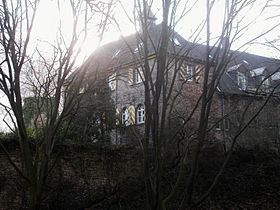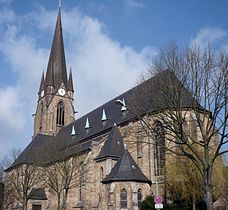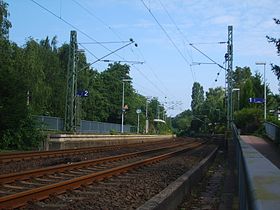Horst (food)
|
Horst |
|

|
|
| Basic data | |
|---|---|
| surface | 4.17 km² |
| Residents | 11,215 (March 31, 2020) |
| Coordinates | 51 ° 26 '14 " N , 7 ° 6' 33" E |
| height | 89 m |
| Incorporation | Apr 1, 1926 |
| Spatial assignment | |
| Post Code | 45279 |
| District number | 46 |
| district | District VII Steele / Kray |
| image | |
|
Essen-Horst, view from the south |
|
| Source: City of Essen statistics | |
Horst is a district in the east of the city of Essen , partly on the Ruhr heights .
location
Horst borders on the districts of Steele , Freisenbruch and, separated from the Ruhr , on Burgaltendorf and Überruhr as well as on the Bochum districts of Höntrop and Dahlhausen . The district can be divided into three areas: the so-called Untere Horst (in the Ruhrauen), the Obere Horst (area located on the mountain) and the Hörsterfeld (a high-rise estate from the 1970s). The closest medium-sized center is in Essen-Steele.
history
The name is derived from the old Saxon word "hurst" for scrub or the old high German word "Horst" for the name of a coppice . Since 955 Horst belonged to the Essen monastery with Steele and the Eiberg and Freisenbruch farmers . In 1226 the community of Horst was forcibly separated from the monastery, which was connected with the murder of Archbishop Engelbert I of Cologne and the execution of Count Friedrich von Isenberg . 1815 Horst came to office Winz-Hattingen , district Bochum . The reason was the reorganization of Europe at the Congress of Vienna . On April 1, 1919 Horst was incorporated into Königssteele together with Eiberg and Freisenbruch . When the law on the reorganization of communal borders in the Rhenish-Westphalian industrial districts came into force on April 1, 1926, Königssteele was incorporated into Steele . Parts of the community were also reclassified to Linden-Dahlhausen and Wattenscheid.
Former coal mining

Like almost all villages in the lower Ruhr, Horst was also long characterized by coal mining . In and around Horst, various small mines were producing early on, with Ruhr shipping initially and soon after the railway taking over the transport of the coal. The Mariannenbahn initially ran through Horst to the Ruhr , a horse-drawn tram from the United Maria Anna Steinbank colliery in Höntrop , the tracks of which were laid on sandstone sleepers.
The Hünninghauser Erbstolln , located south of today's Essen-Steele Ost train station on the western edge of the Horster area, was a mining tunnel that began operations in 1725. He was one of the first to break through the marl cover . The Wecklenbank colliery operated a tunnel in the area of Haus Horst from 1737, which became the Horster Erbstollen in 1835 and was in operation until 1879. Its mouth hole can still be seen in the vicinity of the Horster hydroelectric power station . The Schwarzer Junge gallery in the area of Dr.-C.-Otto-Straße went into operation in 1772. His mine field fell to the Robert colliery in 1920 , which mined with interruptions between 1853 and 1934. The small operation of the Schultenkämperbank colliery began in 1740 and was transferred to Horst Erbstollen and the Eiberg colliery in 1871 . The Fridolin colliery and the Wohlverwahr colliery, founded in 1791 and closed in 1962 as the last colliery in Horst, were also mining .
coat of arms
Blazon : "In silver (white) three upright red horse rams with cords in a ratio of 2: 1."
The coat of arms was designed by Kurt Schweder and never had an official character. At the end of the 1980s, the heraldist created coats of arms for all of Essen's districts. They have meanwhile been well received by the Essen population. The coat of arms is identical to that of the lords of the castle von der Horst .
Districts
Lower eyrie
Large parts of the Lower Horst lie directly on the Ruhr, which is a local recreation area here. In the Ruhr floodplains there are industrial areas and one of the largest cold stores in Germany. In 1856, the New Scotland Mining and Hütten-Aktien-Verein set up a steelworks for the manufacture of rails. Four years later, a smelter, the Freisenbrucher Hütte , was built with two blast furnaces. In 1870 the Martin steel works Union-Horst and in 1885 a screw factory were added. The iron and steel works closed in 1923, and the screw works followed on September 30, 1993. The industrial park that has evolved from it today was bought in 2017 by an investor. In 1723, the Wisthoff glassworks was established in neighboring Steele , which has been operating in Unteren Horst since 1971 and is now part of the Gerresheimer Group.
On Horster Strasse (then Altendorfer Strasse) there is still the old brewery building, which has been a listed building since 1989, including the company villa of the Union brewery Horst-Steele , which was founded here in 1889 by the merchants Bodenheim from Düsseldorf and Knösels from Krefeld. Before the turn of the century, the citizens of Steel, Heinrich Tossen and Schulte-Bäuminghaus, took over the company. In 1914, 20,000 hectoliters of beer were sold. After a slump in sales in the First World War , the Horster brewery was bought up by the Dortmund sister, the later Dortmund Union brewery .
The internationally successful billiards club BF Horster-Eck Essen played in the Horster Eck restaurant in 1959 . Further east, directly on the Ruhr, Essen's largest sports club, MTG Horst 1881 e. V. his domicile (MTG - Märkische Turngemeinde). There was an outdoor swimming pool here for swimming in the Ruhr. Swimming in the Lower Ruhr, and thus also in Horst, was banned in September 1952 by a decree of the Düsseldorf district government, due to the high bacterial content of the water. The ban still applies today.
Upper eyrie
The railway line of the S-Bahn Rhein-Ruhr , on which the line S3 runs, separates the Upper from the Lower Horst. North of the Essen-Horst S-Bahn stop, the Ruhrterrassen housing estate was built between 2013 and 2016 . It is located on the site of the former Altwert demolition company , which went back to a company founded in 1909 by the building contractor Hermann Sprenger.
The center of the village with some shops is located in the Upper Horst. The neo-Gothic Catholic parish church of St. Joseph, which was inaugurated in 1887, is located in the center. The neighboring Evangelical Zion Church with a free-standing bell tower was built in 1957. The Catholic Josef Primary School is in the immediate vicinity. It has existed as Horster School since 1886, right next to the current building, which was built in 1903. During the Third Reich , the school was renamed the Wilhelm Gustloff School until 1945 . Another elementary school is located in Hörsterfeld, the Astrid Lindgren School. There is also a kindergarten.
On the Ruhr heights near the Hörsterfeld are the ground monument of the medieval ring wall system Vryburg and the former knight's seat Haus Horst .
Below the house of Horst, the National Socialists inaugurated the Ruhr Warrior Memorial on November 4, 1934 . It stands for the fallen of the Freikorps, resident services, Reichswehr and police units who fought against the revolutionary workers in the Ruhr area from 1918 to 1920, which led to the Ruhr uprising . With this memorial, the National Socialists tried to enforce their point of view propagandistically in those years , i.e. to degrade the Weimar Republic and the result of the November Revolution and present the seizure of power in 1933 as the salvation of Germany .
A little further to the west is the Villa Vogelsang , a mansion that was owned by the entrepreneur Wilhelm Vogelsang . Used as a monastery in the 1960s, a Linux-themed hotel is now located in the listed building. Below, directly on the Ruhr, is the Horster Mühle hydropower plant with the old lock on the opposite bank of the Ruhr. This was created in 1775 for the Ruhr shipping and is now restored under monument protection. The industrialist Franz Dinnendahl was born about 300 meters upstream from the lock in a mill mentioned in 1319.
Hörsterfeld
From 1973 the large housing estate Hörsterfeld belonging to the district was built for around 6000 people with a shopping street on a former farmland. Most of the skyscrapers were built by the union's Neue Heimat . Later, the city settled an above-average number of people with problematic social backgrounds here. Today there is a certain vacancy in rental apartments, but also an increasing number of conversions in condominiums. A DRK senior citizen center has been built in the northern area on Dahlhauser Strasse since 2015 and moved into at the beginning of 2017.
population
On March 31, 2020, 11,215 residents lived in Horst.
Structural data of the population in Horst (as of March 31, 2020):
- Share of the population under 18-year-olds: 19.9% (Essen average: 16.2%)
- Population of at least 65 year olds: 22.6% (Essen average: 21.5%)
- Proportion of foreigners: 18.2% (Essen average: 16.9%)
traffic
The S-Bahn stops at Essen-Eiberg and Essen-Steele Ost on the Witten / Dortmund – Oberhausen / Duisburg line offer a direct connection to the largest cities in the Ruhr area in a westerly and easterly direction with the S1 line . The Essen-Horst stop on the Essen-Überruhr – Bochum-Langendreer line provides transport links to Hattingen and via Essen main station to Oberhausen with the S3 line .
The bus routes 164 and 184 of the Ruhrbahn connect Horst with Essen-Steele. After the bus route 167 from the S-Bahn stop Essen-Horst to Steele was canceled in December 2019, the replacement bus E64 has been taking over the Ruhrbahn public transport connection from Horst to Steele on the Steeler weekly market days since February 1, 2020.
From 1901 to 1958 there was a first floating bridge over the Ruhr, the Pfennig Bridge. In 1982 the Holtey floating bridge was rebuilt as a foot and cycle bridge.
photos
Ruhr fighter memorial at Haus Horst an der Ruhr
literature
- Gertrude Hermann, Wilhelm Hermann: The old mines on the Ruhr . 4th edition. 1994, ISBN 3-7845-6992-7 , pp. 227-228 .
- Klaus Hermsen: Horst - more than a village . Self-published, 1983.
- Wolfhart Hoffmann: Nature on the Ruhr near Essen-Horst: image documentation . Bacht, Essen, 1997, ISBN 3-87034-055-X .
- Tim Schanetzki: 125 years of stove bench. Zeitgeist and living in Horst.
- Franz van der Kemp: Attention, attention! End end! The story of a childhood in dark times 1932–1951. 2003, ISBN 3-00-011993-0 .
- Irene Voigt: Burg Horst: The story of an old house on the Ruhr 1142–1983 . Pomp and Sobkowiak, Essen, 1983, ISBN 3-922693-54-7 .
See also
Web links
- "We are Essen", Ed. Essener Marketing GmbH, 2010 - pp. 33 to 38, PDF 3MB , last viewed on June 22, 2012
Individual evidence
- ↑ Gerhard Koelber: Old Saxon Dictionary: Letter H. 2013, accessed on February 27, 2018 (Assamese, German, English, Latin).
- ↑ a b c Steeler Citizenship eV - Steeler Chronicle ( Memento of the original from March 23, 2010 in the Internet Archive ) Info: The archive link was automatically inserted and not yet checked. Please check the original and archive link according to the instructions and then remove this notice. last viewed on October 29, 2010, offline
- ^ Website of the home history circle Eiberg
- ↑ a b Stephanie Reekers: The regional development of the districts and communities of Westphalia 1817-1967 . Aschendorff, Münster Westfalen 1977, ISBN 3-402-05875-8 , p. 254 .
- ↑ Friends of Mining Historic Sites in the Ruhr Area eV (ed.), Karlheinz Rabas, Karl A Rubach: Mining History Atlas for the City of Essen, 2008, ISBN 978-3-929158-22-9
- ↑ See also Johann Rainer Busch: Kurt Schweders Wappen der Essener Stadtteile Essen 2009, p. 90.
- ↑ Dahlhauser Strasse in Essen had a heart made of iron ; In: Westdeutsche Allgemeine Zeitung of January 13, 2018; accessed on February 6, 2018
- ↑ Excerpt from the list of monuments of the city of Essen , accessed on February 6, 2018
- ^ Karl Hansmann: Unpacking an old house: Von Hölzken op Stöcksken; Norderstedt: Books on Demand GmbH, January 2005, ISBN 978-3-8334-2407-6
- ↑ DerWesten.de: New approach for swimming in Ruhr and Baldeneysee, July 6, 2010, accessed on February 6, 2018
- ↑ "Historical" on the Josefschule homepage ; accessed on February 6, 2018
- ^ DerWesten.de: district walk, "In Hörsterfeld there is always a fresh wind" ; accessed on February 6, 2018
- ↑ Derwesten.de of March 17, 2016: The new DRK home in Horst is to become a social center for everyone ; accessed on February 6, 2018
- ↑ Population figures of the districts
- ↑ Proportion of the population under 18 years of age
- ↑ Proportion of the population aged 65 and over
- ↑ Proportion of foreigners in the city districts
- ^ Ruhrbahn
- ↑ New e-bus service between Horst and Steele ; Press release of the city of Essen from January 29, 2020










